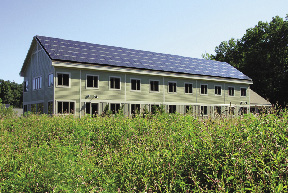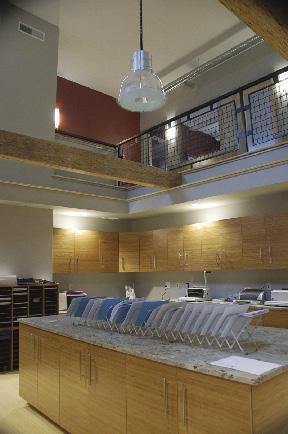New England Environmental, Inc. (NEE) and Kuhn Riddle Architects (KRA) said that NEE's headquarters has received the highest honor offered by the U.S. Green Building Council's Leadership in Energy and Environmental Design (LEED) rating system, LEED Platinum.
Designed by Kuhn Riddle and built by Arrowwood Construction, the 16,000 s/f office building is one of only five buildings in Mass. and the first in Western Mass. to receive LEED Platinum for New Construction, according to the USGBC database. The Platinum designation marks the project as having achieved the highest levels of sustainable construction as established by LEED's internationally-recognized green building certification system.
Given the high-profile, big-budget nature of many LEED-NC Platinum projects, NEE and KRA are pleased to redirect the focus to small-town New England.
"This project illustrates how vital, progressive work is happening in smaller towns throughout the region," said Ann Marshall, AIA, Kuhn Riddle project architect. "NEE has achieved levels of energy-efficiency that too often are assumed to be out-of-reach for smaller commercial projects without substantial budgets, even in larger urban centers."
The idea that a small business could build sustainably was an important point from the beginning for NEE.
"We set-out to demonstrate that an environmentally sustainable building can also be an economically sustainable building," said Julie Marcus, NEE director of operations. "The NEE building actually cost less per square foot than most conventional buildings, was designed and built using local talent and materials, and was finished on-time and on-budget."
Among its many sustainable features, a 40 kW photovoltaic solar array and 12" thick exterior walls allow the building to create and to conserve energy, making it far more efficient than a conventional commercial building. NEE estimates their energy cost savings to be approximately $21,000 per year.
The project also acts as a testing ground for site strategies that NEE often uses in its environmental consulting work. "Building our own office was a wonderful opportunity to showcase and observe the effectiveness of the Low Impact Development techniques we are always recommending to our clients," said Marcus. The site design includes bio-swales, rain gardens, porous asphalt, and grass pavers, all of which contribute to a zero-increase in the volume of storm water run-off.
During construction, Arrowwood and its subcontractors diverted 82% of construction waste from landfills. Almost half of all materials used in the project (by value) were locally manufactured or extracted. Five percent are rapidly renewable materials.
Since moving into the new building in February 2010, NEE has hosted school groups, community organizations, and many others who were curious about the building. Marcus estimates that they have given over 500 tours over the last 18 months.
Of the more than 23,000 buildings that have been registered with USGBC since 2000, 7,800 have received some level of certification. There are 245 LEED New Construction Platinum buildings in the U.S., five of which are in Mass.
LEED was developed by the U.S. Green Building Council (USGBC) in 2000. It establishes parameters with which designers, owners, and operators can evaluate and implement sustainable solutions for design, construction, operation, and maintenance of buildings.
 (1).jpg)









.png)